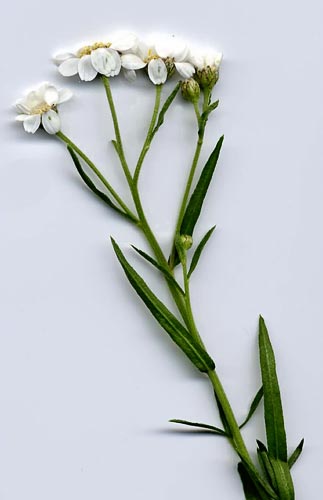Weeds
Ptarmica vulgaris Blakw.ex DC - Sneezewort, Sneezeweed
Systematic position.
Family Asteraceae, genus Ptarmica L.Synonym.
Achillea ptarmica L.Biological group.
Perennial clustered-root weed.Morphology and biology.
Stalk 30-60 cm in height, straight, simple or paniculate-branchy, ribbed, glabrous in lower part, with usually dense decumbent pubescence. Leaves 2-6 cm in length, integral, alternate, sessile, narrowly-lanceolate, pointed, appressed-serrate along margins. Calathidia 10-17 mm in diameter, aggregated in apical loose or dense corymbose inflorescences. Involucre hemispherical, consisting of 3-4 rows of imbricated coriaceous leaflets of 2.5-3 mm length. Receptacle slightly convex, having membranes. Marginal flowers of calathidium uniseriate, pistillate, 9-13 in number, with ligulate corolla; tubule of corolla 1 mm in length; limb 2-4 mm in length, white, widely obovoid or nearly round, with 3-4 blunt dents at apex. Median flowers bisexual, numerous, with tubulate-infundibulate flattened corolla having 5 dirty-white lobes. Hemicarps 1.5-2 mm in length, oblong or obovoid, flattened, with truncated top, light gray, without pappus. Blossoms from June until September.Distribution.
Scandinavia, Middle and Atlantic Europe, Western Mediterranean, Balkan Peninsula. In the territory of the former USSR the species is distributed in western part of Arctic regions, in Baltic, northern, middle, and partly southern regions of the European part of the USSR; in Western Siberia (adventive).Ecology.
The plant grows in damp meadows, forest edges and clearings in mixed and deciduous forests, in glades, along banks of rivers, lakes and springs, on peat bogs, among bushes, at roadsides, along ditches, in disturbed habitats.Economic significance.
The weed grows in fields of perennial grasses and winter cereals mainly with 2 points of abundance. It meets also at field margins, in kitchen gardens, sparsely or by groups, sometimes abundant. Control measures include cleaning seed grain and soil, eradication of Sneezewort rhizomes by use of soil treatments and herbicide applications.Reference citations:
Bakin, O.V., Rogova, T.V., Sitnikova, A.P. 2000. Vascular plants of Tatarstan. Kazan: Kazan University. 496 p. (in Russian).Shishkin, B.K., ed. 1963. Botanical atlas. Moscow & Leningrad: Selkhozgiz, 504 p. (in Russian).
Shishkin, B.K., ed. 1965. Flora of the Leningrad Region. V. 4. Leningrad: LGU. 356 p. (in Russian).
Shlyakova, E.V. 1982. Field-weed plants of the Non-Chernozem zone of RSFSR. In: Korovina O.N., ed. Catalogue of VIR world collection. N 338. Leningrad: VIR. 116 p. (in Russian).
Tsvelev, N.N. 2000. Keys to the vascular plants of North-West Russia (Leningrad, Pskov and Novgorod Regions). Saint-Petersburg: SPbSCPA press. 781 p. (in Russian).
Ulyanova, T.N. 1998. Weeds in the flora of Russia and other CIS states. St. Petersburg: VIR. 344 p. (in Russian).


